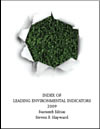
Steven Hayward is not only the author of the forthcoming “The Age of Reagan, 1980-1989: The Conservative Counterrevolution. He is also the author of the fourteenth annual edition of the Index of Leading Environmental Indicators, just published to coincide with Earth day and Lenin’s birthday. The 61-page pamphlet is published by the Pacific Research Institute and available in PDF here.
Steve’s annual reports are a chronicle of environmental progress. They are a counter to the doomsaying that is the stock in trade of the left. Steve explains that he “was inspired to do this by Bill Bennett’s famous Index of Leading Cultural Indicators back in 1993; that was mostly bad news — crime rates, test scores, teen pregnancy, etc — in simple time-series charts and graphs. I knew the same treatment of environmental trends in the U.S. would show mostly good news.”
Steve cedes Bill Bennett the advantage of a subject matter devoted to sex, drugs, and rock ‘n roll, while he takes up polychlorinated biphenyls and sulfur dioxide: “No wonder his got more media attention.” As for this year’s edition, Steve identifies what might be his favorite tidbit:
Elizabeth Rosenthal reported in the New York Times of a recent estimate from the Smithsonian Institution research in Central America suggesting that “for every acre of rain forest cut down each year, more than 50 acres of new forest are growing in the tropics on land that was once farmed, logged or ravaged by natural disaster. . . The new forests, the scientists argue, could blunt the effects of rain forest destruction by absorbing carbon dioxide, the leading heat-trapping gas linked to global warming, one crucial role that rain forests play. They could also, to a lesser extent, provide habitat for endangered species.” The next sentence, however, has a drearily predictable beginning: “The idea has stirred outrage among environmentalists,” not because it might be untrue, but because it might blunt support for “vigorous efforts to protect native rain forests.”
What would any MSM environmental report be without the obligatory outrage among environmentalists?
UPDATE: I should have noted that Mark Steyn leads off his column this week as follows:
According to an Earth Day survey, one-third of schoolchildren between the ages of 6 and 11 think the Earth will have been destroyed by the time they grow up. That’s great news, isn’t it? Not for the Earth, I mean, but for “environmental awareness.” Congratulations to Al Gore, the Sierra Club and the eco-propagandists of the public education system in doing such a terrific job of traumatizing America’s moppets. Traditionally, most of the folks you see wandering the streets proclaiming the end of the world is nigh tend to be getting up there in years. It’s quite something to have persuaded millions of first-graders that their best days are behind them.
Steve’s annual report on envrionmental progress is the antidote to the environmentalists’ poison.
Environmental Progress Continues
Scott Johnson
Steven Hayward is not only the author of the forthcoming “The Age of Reagan, 1980-1989: The Conservative Counterrevolution. He is also the author of the fourteenth annual edition of the Index of Leading Environmental Indicators, just published to coincide with Earth day and Lenin’s birthday. The 61-page pamphlet is published by the Pacific Research Institute and available in PDF here.
Steve’s annual reports are a chronicle of environmental progress. They are a counter to the doomsaying that is the stock in trade of the left. Steve explains that he “was inspired to do this by Bill Bennett’s famous Index of Leading Cultural Indicators back in 1993; that was mostly bad news — crime rates, test scores, teen pregnancy, etc — in simple time-series charts and graphs. I knew the same treatment of environmental trends in the U.S. would show mostly good news.”
Steve cedes Bill Bennett the advantage of a subject matter devoted to sex, drugs, and rock ‘n roll, while he takes up polychlorinated biphenyls and sulfur dioxide: “No wonder his got more media attention.” As for this year’s edition, Steve identifies what might be his favorite tidbit:
Elizabeth Rosenthal reported in the New York Times of a recent estimate from the Smithsonian Institution research in Central America suggesting that “for every acre of rain forest cut down each year, more than 50 acres of new forest are growing in the tropics on land that was once farmed, logged or ravaged by natural disaster. . . The new forests, the scientists argue, could blunt the effects of rain forest destruction by absorbing carbon dioxide, the leading heat-trapping gas linked to global warming, one crucial role that rain forests play. They could also, to a lesser extent, provide habitat for endangered species.” The next sentence, however, has a drearily predictable beginning: “The idea has stirred outrage among environmentalists,” not because it might be untrue, but because it might blunt support for “vigorous efforts to protect native rain forests.”
What would any MSM environmental report be without the obligatory outrage among environmentalists?
UPDATE: I should have noted that Mark Steyn leads off his column this week as follows:
According to an Earth Day survey, one-third of schoolchildren between the ages of 6 and 11 think the Earth will have been destroyed by the time they grow up. That’s great news, isn’t it? Not for the Earth, I mean, but for “environmental awareness.” Congratulations to Al Gore, the Sierra Club and the eco-propagandists of the public education system in doing such a terrific job of traumatizing America’s moppets. Traditionally, most of the folks you see wandering the streets proclaiming the end of the world is nigh tend to be getting up there in years. It’s quite something to have persuaded millions of first-graders that their best days are behind them.
Steve’s annual report on envrionmental progress is the antidote to the environmentalists’ poison.
Nothing contained in this blog is to be construed as necessarily reflecting the views of the Pacific Research Institute or as an attempt to thwart or aid the passage of any legislation.